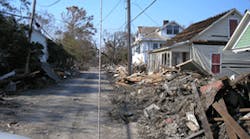After Hurricane Katrina ravaged the Gulf Coast, fleets turned to satellite communication systems as the only reliable means of communication when cellular links and landlines failed.
Pelzer, SC-based Owen-Kennedy Specialized Transport sent a 4x4 pickup— normally used to tow horses to horse shows— equipped with a Qualcomm OmniTRACS mobile communications system to Bay St. Louis, MS. The pickup was used to find a route for a larger truck, also equipped with the system and hauling a trailer full of supplies, to reach the Bay St. Louis area.
Both vehicles stationed themselves at an old train depot, which was established as an emergency relief center for the county. For the next two days, the donated items from the semi-trailer were distributed to victims of the hurricane.
After the supplies were distributed the trucks remained so that its Qualcomm system could be used to coordinate relief efforts between local and state agencies, set up routes for the pickup truck to locate survivors within the battered neighborhoods, and allow residents to relay messages to concerned friends and family across the country.
The Owen-Kennedy’s dispatch office in Pelzer was transformed into a communications hub for these efforts. “Basically we sent a smaller four-wheel-drive truck initially with OmniTRACS installed to communicate back and fourth and to find a route for the bigger truck,” Tare Kennedy co-owner and safety director of Pelzer, SC-based Owen-Kennedy Specialized Transport told FleetOwner. “But as far as the Qualcomm equipment goes, we couldn’t have coordinated without it. There were low power lines everywhere and we wouldn’t have known where to take the supplies to.
“The initial pickup truck made contact with the emergency operations center in town near the fire department and coordinated efforts for the fire department,” Kennedy continued. “We got a 250-gallon tank of diesel fuel to keep the local fire truck running. We had generators, a lot of basic medical supplies, we had baby diapers, fruit juices, cereals— everything under the sun. We packed the trailer full.
“The first food going in that first trailer went to a convalescent home. About 90% of the food went to the elderly and two generators were sent in. Our mission was to be part of a mass supply effort to get to this small town where we have roots and history… and to get these people what they needed to survive.”
Kennedy spent most of his childhood in Waveland, MS, which borders Bay St. Louis. The municipality is a densely populated small city known for being an ideal vacation area for its sailing, sport fishing, and proximity to casinos. Before Katrina, Kennedy’s mother owned a 5,000 sq-ft home built on poured concrete with reinforced walls. It was “hurricane proof” but now all that remains is the foundation.
The entire county appeared to be completely isolated from state and federal aid upon the trucks’ arrival, Kennedy said. “Waveland was probably one of the last places to get aid from the government. People were literally scrounging what they could to survive. Without communications they can’t ask for outside help and quite frankly, no one came in to check.
“There was little fire department and the EMS were overwhelmed. You take a fire department with 10 to 12 people total and a population of 100,000 and an EMS with maybe eight to ten ambulances and 15 personnel and they won’t make a dent. In 24 hours they were out of supplies and gas.
“The Qualcomm system-- through us getting that truck there, communicating and relaying through Mississippi Emergency Management Agency (MEMA) we determined that these people needed help,” Kennedy explained. “[The Qualcomm system] was the hub for us. My team and I were dealing with the fire chief of Bay St. Louis and the mayor. We were talking with MEMA. All the messages were relayed through our Pelzer dispatch office. We told MEMA that the mayor of Bay St. Louis needed help and MEMA was able to cross-check what I was telling them. They knew I wasn’t coming up with the city officials name off the top of my head.”
Kennedy is convinced that a reliable communication system was the difference between Bay St. Louis receiving no federal aid, and lots. He pointed out that New Orleans received a lot of relief more quickly because of the news coverage the city was getting.
“Eventually, CNN’s Anderson Cooper went to Bay St. Louis and literally, the next afternoon there was everything [in terms of federal aid],” said Kennedy. “Without us relaying information to MEMA, and CNN getting in there to get a public eye and political [pressure] on why this town hadn’t gotten any support, I don’t know what would have happened. You’d have a hard time convincing me that Qualcomm indirectly didn’t have a part in this. If [local officials] had been able to get in touch with the outside world they would have done it but they were essentially trapped.”
Additionally local residents would ask to use the Qualcomm system to relay a message to their friends and relatives across the country. “They’d give us a phone number so their loved ones knew that they were okay— that they survived. We’d also go out and check for survivors. There was GPS on the pickup to make sure we had the right coordinates. When we couldn’t find the right address, we at least verified it with the coordinates. If we didn’t actually find survivors we’d tell them, ‘This is what the house looks like, there are footprints, someone’s here and taking care of things.’
"It was more of a humanitarian type of run. We did a lot but I feel we didn’t do enough. What we did is the least any human could do for another one."
For more information on Qualcomm OmniTRACS, go to www.qualcomm.com.




